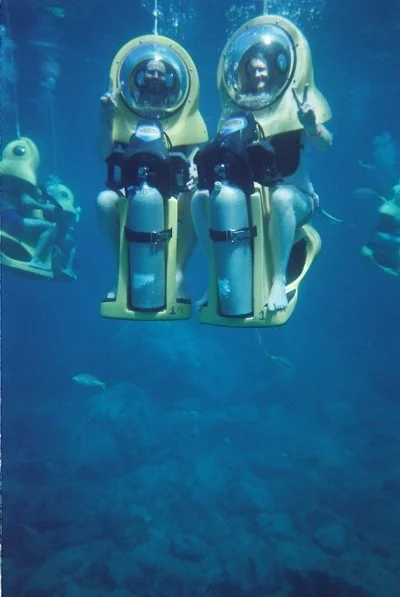Sun, sea, sand and planes coming in to land at Maho Beach, Sint Maarten

The first thing that greets us at Maho Beach is a sign in big red letters:
DANGER. Jet blast of departing and arriving aircraft can cause severe physical harm resulting in extreme bodily harm and/or death.
For once, this is not health and safety overkill. In 2017, a woman died after she was blown backwards, hitting her head off concrete. Several other serious injuries have been recorded although no other deaths have been reported – at least publicly.
And yet, people flock here. Today, we are among them.
Maho Beach, on the Dutch side of the Caribbean island of Saint Martin, is one of the few places in the world where you can get up close to aircraft in the final seconds before they hit the tarmac. All that separates everyone on the beach from probable death is a metal fence slightly over head height.
When we arrive, it is busy. But we find our space, roughly in the centre, smack bang in the middle of the flight path. The sea is less than two metres away. The odd rogue wave conspires to almost inundate our compact base camp of towels and sun cream. Roughly eight metres behind us is the red-lettered sign and the metal fence. We are somewhat wedged in, but comfortably so. Maho Beach is not the largest beach in the Caribbean, but it has those crystal clear waters you find on most. The strip of sand is exactly that – a strip. A mere three or four metres under the waves the floor drops away. Even more curiously, there is nothing in the way of vegetation. My curiosity will get the better of me later in the day and I will look up Maho Beach in our guide book. I will learn that nothing grows here because of the jet blasts of the aircraft. There is such a thing as ‘jet blast erosion’. I will be grateful I did not know this at the time, when we were waiting for yet another aircraft to land.
Nothing can actually prepare you for experiencing what it’s like to being this close to aircraft flying this closely overhead. Our photos really do not do it justice. Most are less than 30m above ground level, but they feel a lot closer than that.
The planes come regularly, sometimes thick and always fast. The majority are smaller planes, delivering freight. But roughly one in seven is a larger passenger plane. When one of these is spotted on the horizon, everyone takes note. Most people prefer to stay at the top of the beach, as close to that fence as they can safely get. But I choose to experience most of the landings from the water.
At one point, I swim out further than anyone else. Realistically, I am a mere twenty or so metres from the shore. But I feel like I’m alone in the middle of the ocean. I’m not treading water for long before I glimpse a white shape shimmering over the water. A jumbo jet. It’s coming right for me. That’s how it feels. It’s a strangely lonely feeling. Antony is a minute’s swim away, along with several hundred other beach denizens. And yet, preposterously disastrous outcomes fill my mind. I can't help it. What if the pilot clips his control stick just slightly and strikes the water, killing me instantly? What if a giant wave (not unheard of at Maho Beach, which is popular with windsurfers) lifts me high in the water and I am sucked into one of the jet’s turbines? What if…
Where are these prognostications of doom coming from? My only explanation is that this is something akin to what the French call L’appel du vide. Literally, the call of the void. It's that feeling you get when you're on a bridge, or the top of a skyscraper, and a tiny part of your mind wonders what it would be like to chuck yourself off.
Except in this case, the situation is inverted. The sea is the void. I am in the sea. The sea, and I, are calling to the plane. Fall into us.
The jumbo jet screams overhead. The feeling vanishes. Until the next plane is seen on the horizon that is. Eventually, I leave the sea and I walk up the beach feeling grateful to be alive.
Reluctantly, we drag ourselves away from the invigorating threat of imminent death and take seats at the Sunset Bar and Grill. The drinks are unfussy versions of classic cocktails and reasonably priced considering the prime location. At the left hand of the beach, we can still see the planes coming in between sips. The entire bar was destroyed by Hurricane Omar in 2008. The same hurricane also took most of the beach, reducing it to the boulder-backed strip it is today.
In the rebuilt Sunset Bar, a dance contest gets underway, but everyone can still hear the planes landing above the pounding music. The bar staff don’t even look up. For them, being this close to the void is normal.
We ended up spending roughly three hours at Maho Beach, witnessing several dozen aircraft landings. Who knows how much ‘jet blast’ erosion we experienced in this time. Who knows how many months we may have shaved off our lifespans. It was worth it.
Maho Beach is well served by minibus taxis from the cruise terminal. The journey takes approximately half an hour each way, giving you a tour of the South West coast of the island in the process. After entering the terminal, carry straight on past most of the shops and, on the right, look for shelters with red tiled rooves. The queueing is a little chaotic but doesn’t take that long. A return ticket is $16 per person.
















